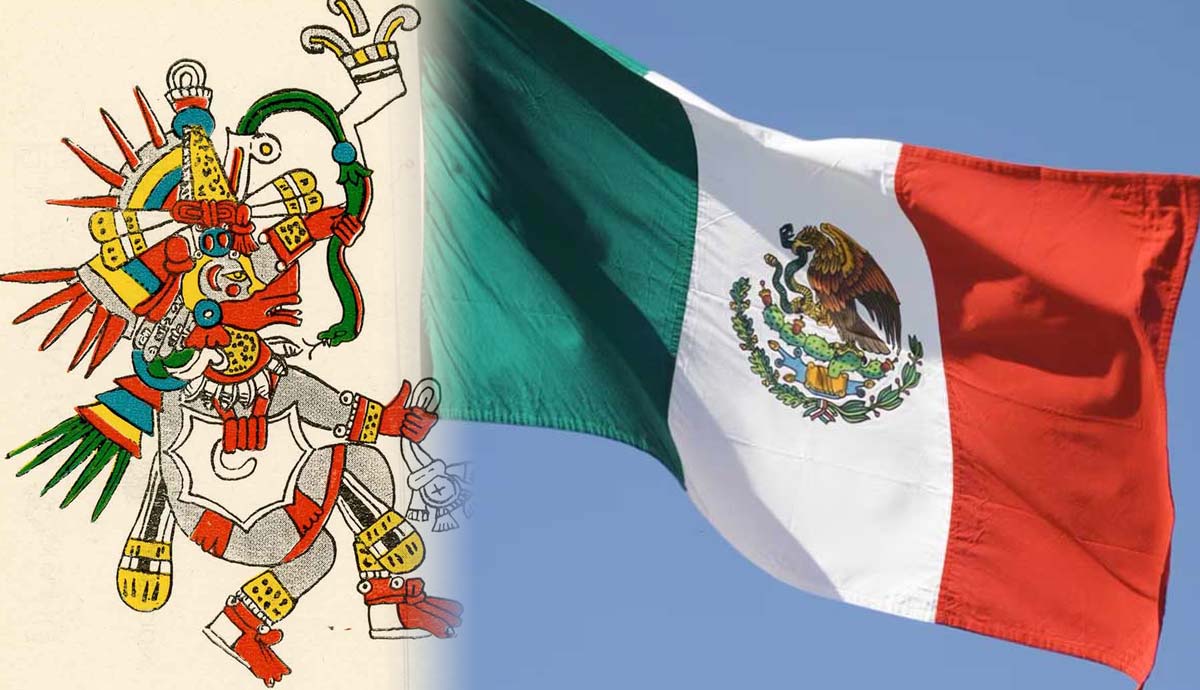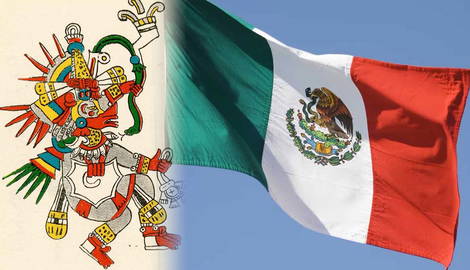
Before he was identified as an indigenous god, Quetzalcoatl was simply a peculiar snake-bird carving on a broken stone tablet found in Mexico—a carving, it turns out, from the Mesoamerican mother culture, the Olmecs. This appearance was the first of many, as explorations revealed the iconography of the feathered serpent peppered throughout Mesoamerican history, across cultures and religions, right up until the Conquistadors appeared. At one time, even blamed for the success of the Spanish conquest, Quetzalcoatl is an enduring example of how the line between myth and history can become blurred.
As Above, So Below: The Myths of the Feathered Serpent

A ubiquitous Mesoamerican deity occupying space in both the Aztec and Mayan pantheons, the feathered serpent was known by two primary names. Quetzalcoatl, the Aztec name, comes from the Nahuatl language, combining quetzal, a species of brightly feathered bird, and coatl, “snake.” The Mayan name, Kukulkan, is derived from the Yucatec Maya dialect, combining kukul, feathered, and kan, which was used for both “sky” and “snake.” In Mayan iconography, the snake is associated with life above and below the earth, pictured alternately in myth as a snake boy who grew too large and had to be hidden in a cave, and a winged serpent that flew too close to the sun and became the sun’s pet.
Beyond these stories, little is known about the Mayan Kukulkan, though his existence supports the theory that the feathered serpent motif is much older than either the Maya or the Aztec, likely dating to the much earlier Olmec civilization (1600–400 BCE). During what is generally referred to as the Formative period, Olmec and Mayan territories overlapped in the highlands of Guatemala, where Mayans continue to live to this day.
Much of what is known today of pre- and immediate-post-colonial Mesoamerican civilizations comes from extant written records, known as codices. The Aztec and Mayan codices were screenfold manuscripts, painted on front and back, made either of leather or the bark of various trees. The oldest known Mayan codex (Dresden) dates from around 1200 CE, though it may be a copy of an earlier book. Others, such as the Aztec codices, are more recent, often bearing the signs of Spanish influence, which calls their veracity into question. While examples of pre-conquest Mayan and Mixtec codices are known to exist, very few—as many as five, but as few as one—can be attributed to the Aztecs. Though more are known to have been written, some fell victim to the hot damp environment of the jungle, while others were burned by Catholic priests.

In addition to information about the astronomy of Aztec and Mayan civilizations, the codices provide a clear picture, literally, of their creation myths. The Aztec myth begins with the old god Ometoltl (from ome, “dual” and teotl, “divine”), a creator deity whose dual aspects resulted in the binary Ometecuhtli (male) and Omecihuatl (female) deities. Interestingly, little attention seems to have been paid to these creator deities and no temples were dedicated to them, since it was believed that people communicated not through them but through their four sons: Huitzilopochtli, Tezcatlipoca, Quetzalcoatl, and Xipe Totec.
Of the four brothers, Tezcatlipoca and Quetzalcoatl were principally responsible for the creation of the world, or worlds, of which the Aztec believed there were four previous. Each world was created through the combined efforts of the brothers, embodying the dual aspects of light (Quetzalcoatl) and dark (Tezcatlipoca), good and evil, like two sides of the same deity. Alternately, one brother would decide that the other had messed up and destroyed his creation. After the fourth creation, it was Quetzalcoatl’s turn again. He descended into the underworld, Mictlān, to collect the bones of the dead from the previous four creations to create the people of the fifth, which included the Mexica.

The equivalent of Ometeotl in Mayan mythology is Itzamná. The word Itz has many meanings including “magic,” “magician,” and “witch,” but also “dew” and “essence.” Like Kukulkan, the lizard god Itzamná was associated with both the upper and lower worlds and had two names: Itzam Yeh (Bird of Heaven) and Itzam Cab Ain (Earth crocodile). Itzamná also had a female counterpart, Ixchel, and together they produced many offspring, including four brothers known as bacabs who, like the four main deities of the Aztec pantheon, each represented a color and a direction.
Mayan mythology diverges between two main groups: the K’iche’ and the Yucatec. Each had a different name for the feathered serpent, the more well known being Kukulkan, in use among the Yucatec. In present-day Guatemala, the feathered serpent was called Gucumatz (Q’uq’umatz). Beginning around 1500 BCE, the Maya have occupied highland Guatemala in one form or another, but no written records of their creation story have been found prior to the writing of the Popol Vuh, the “Mayan bible,” between 1554-1558 CE. Unlike the earlier Yucatec creation story featuring Itzamna and Ixchel, the Popol Vuh substituted Gucumatz and his brother, Tepeu, the K’iche’ equivalent of Tezcatlipoca, as creator gods, resulting in a somewhat simplified version of the Aztec and Yucatec stories of four brothers.
In The Aztec Kings, Susan D. Gillespie states that composite deities, such as Kukulkan or Quetzalcoatl, serve as mediators between humanity and the gods, allowing the gods to live in both worlds, thereby making the supernatural, natural, and vice versa.
Myth to Man: The Evolution of Quetzalcoatl

Apart from its cultural and mythological associations, Quetzalcoatl/Kukulkan became a common cultural and ethnic motif among the Toltec and Maya during the late classic period (800–925 CE) and among the Aztec and Maya during the Postclassic and late Postclassic periods (925–1530 CE), perhaps helping to ease relations between the Itzas of the Yucatan and the Aztecs to the west and central Mexico.
Following the Olmecs, the next evidence of the feathered serpent was found in Teotihuacan (150 CE–600 CE) at the Temple of the Feathered Serpent. While the builders of Teotihuacan were neither Mexica nor Maya but a separate culture, since the city was syncretic in structure, it is likely that the Mayans acquired the iconography of the feathered serpent there and took it with them when they established their own thriving civilization during the Classic period.
The earliest versions of the feathered serpent appear as a snake with a feathered headdress, but as the iconography developed, the figure took on anthropomorphic features and subsequently became identified with human rulers as much as the revered deity itself. By Aztec times, the figure was fully anthropomorphized and associated principally with the Toltec hero, Topiltzin Quetzalcoatl, later to be associated with Kukulkan and the great Mayan metropolis, Chichen Itza.
According to legend, Topiltzin Quetzalcoatl was the incumbent lord of Tula, capital of the Toltec Empire, near the time of its fall, around 1170 CE. Topiltzin’s reign was sabotaged by the devotees of the Aztec “devil” Tezcatlipoca, “Smoking Mirror,” a trickster god of war and human sacrifice. As the story goes, Tezcatlipoca appeared to Topiltzin Quetzalcoatl as an aged man and offered him a drink of a sweet, intoxicating potion, pulque, which caused Topiltzin to neglect his priestly duties and sleep with his own sister. Naked and ashamed, Topiltzin left the city of Tula and headed west with a group of his followers, making his way to the ocean where, depending on who tells the story, he either sacrificed himself to flame or sailed off on a raft of snakes promising to return.

Around this time the Yucatec Mayans of Chichen Itza speak of a group arriving from the west led by a man identifying as, and dressed in the garb of, the feathered serpent. Their name for this man was Kukulkan, the same feathered serpent deity that the Mayans had been venerating since the classic period, and presumably earlier versions from the Olmec Preclassic period in Guatemala.
As showcased often throughout the history of civilization, as rulers grow in power, so too does their opinion of themselves. They live in the best dwellings, eat the finest food and do little to no physical work—who wouldn’t begin to feel a little like a god? Considering the long pedigree of feathered serpent iconography on everything from pottery to friezes to stelae, the symbol would seem to suggest an association with greatness, lending legitimacy to one’s family or, in the case of the Aztecs, to their entire civilization.

From this perspective, Quetzalcoatl was not simply a deity or a mythological figure. He, or rather it, represented the priestly class that helped carry civilization through its various ups and downs. When the Aztecs founded their magnificent city, Tenochtitlan in what is now Mexico City, they had been migrating south for two hundred years. According to their story, they had come from Aztlan, a remote and possibly mythical place in the North. At that time they were simple nomads whose principal deity was Huitzilopochtli (Hummingbird on the Left).
While wandering in the desert, Huitzilopochtli spoke to them from a tree, instructing them to go off in search of a new land and bestowing on them a new name: Mexica. Along the way, they settled briefly at Tula, a Toltec site that they promptly appropriated, along with the claim to Toltec heritage. They did not stay long though. As soon as their leaders had convinced themselves and their people of their rightful place as Toltec descendants, they burned what was left of Tula and set out with a new plan, given to them once again by Huitzilopochtli: to look for a sign in the form of an eagle with a snake in its mouth—an obvious feathered serpent reference—which they finally found 40 miles south on an island in the middle of Lake Texcoco.
Quetzalcoatl Returns? The Rise and Fall of Tenochtitlan

By 1345, the Mexica had succeeded. In the span of 174 years, they had transformed the swampy marshland they’d discovered into a metropolis of 8 square miles, with as many as 200,000-500,000 inhabitants, the largest city outside of China at the time.
Upon first laying eyes on the city of Tenochtitlan in 1519, Hernán Cortés and his fellow Spaniards were amazed. With the arrival of these Europeans, though, a number of apocryphal accounts begin to arise, including the popular theory that the emperor Montezuma believed Cortés to be the return of Quetzalcoatl, bringing the feathered serpent to the attention of Europeans. Suspiciously, Cortés himself never mentioned being received as a god in any of his letters, and records show that Montezuma had already been informed of Cortés’s existence long before his arrival in Tenochtitlan. The conflation of Cortés with the gods likely came from uncertainty on the part of the indigenous peoples over what to call the Spaniards as a group. Since many of them acted as missionaries, the Aztecs may have used the word teotl to refer to them, a Nahuatl word often translated as “god,” but that in fact embodies many facets of divinity and spirituality. For his part, Cortés would have quickly belied any notion of himself as a long lost Aztec deity, as he moved quickly to vandalize an Aztec temple where he was given lodgings, stage a revolt with the help of his Tlaxcalan allies, and imprison Montezuma, ultimately resulting in the fall of Tenochtitlan.

Like many things related to pre-conquest Mesoamerica, myth and history have become blurred, due in no small part to the cyclical nature of time in both Mayan and Aztec calendars, where events are anticipated to recur over and over again. Worlds are created and destroyed. It is just one more aspect of the feathered serpent myth that continues to evolve.









